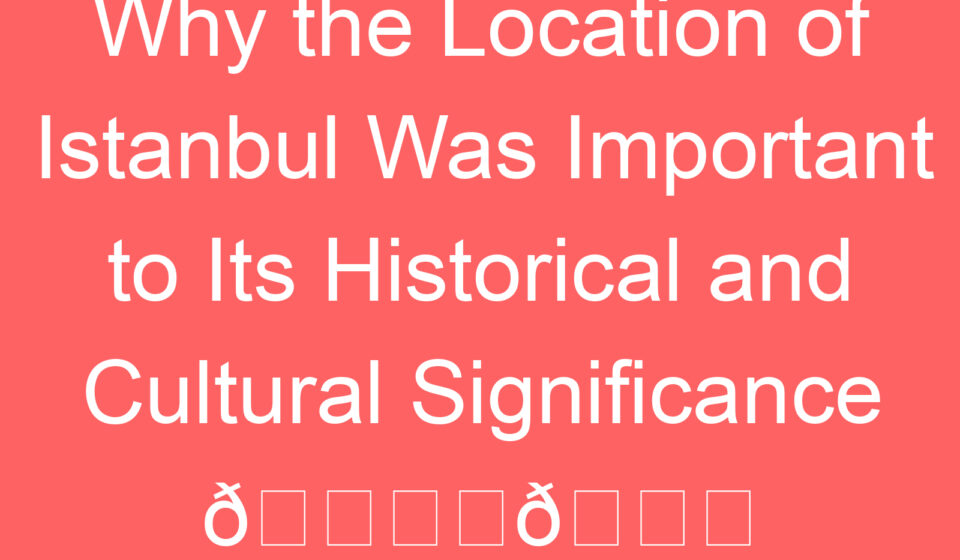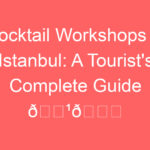
Why the Location of Istanbul Was Important to Its Historical and Cultural Significance 🏛️🌏
Istanbul is one of the most historically and strategically significant cities in the world. Its location at the crossroads of Europe and Asia, controlling the only passage between the Black Sea and the Mediterranean, has allowed it to serve as the capital of three major empires: the Roman (Byzantine), Ottoman, and briefly the Latin Empire.
Table Of Content
For tourists, understanding the city’s unique geography helps appreciate its rich history, culture, economic importance, and the many stories hidden in every corner of the city. Walking through Istanbul allows visitors to experience layers of history from ancient to modern times, with streets, monuments, neighborhoods, and hidden alleys reflecting centuries of strategic planning, cultural exchange, and economic prosperity.
Beyond the historic sites, Istanbul offers diverse experiences, from traditional Turkish baths and tea gardens to modern art galleries and lively street markets, all shaped by its geography and historical significance.
Strategic Geographic Position 🌍🚤
The city sits on the Bosphorus Strait, connecting the Black Sea to the Sea of Marmara, and ultimately the Mediterranean. This positioning has made Istanbul a critical junction for trade, cultural exchange, and human migration between East and West for thousands of years. Emperor Constantine the Great recognized its potential and chose the site for his new capital in 330 CE, citing its control over key trade routes, military passages, and access to diverse populations and resources. Today, Istanbul remains a living testament to strategic foresight, with every bridge, ferry line, and waterfront neighborhood illustrating the ongoing importance of its location.
Tourists can see this strategic location in action by taking a Bosphorus cruise 🚢, which showcases the city stretching across two continents, highlighting the seamless blend of European and Asian influences alongside thriving modern urban life. Along these cruises, visitors can observe historical landmarks, small fishing villages, luxurious waterfront mansions, and bustling ports that reflect centuries of continuous adaptation and growth. Walking along the shores, tourists can witness local fishermen, waterfront cafes, and street artists that give life to the city’s cultural vibrancy.
Natural Defensive Advantages 🏰🛡️
Istanbul’s geography provided natural fortifications that made it nearly impregnable for centuries. Situated on a rocky peninsula surrounded by water on three sides—the Sea of Marmara to the south, the Bosphorus to the east, and the Golden Horn to the north—the city was easily defensible against naval and land attacks. Approaches from the west were blocked by the Theodosian Walls, a massive fortification system that repelled numerous sieges and remains a marvel of ancient engineering.
The Golden Horn, a 7.5 km long natural harbor ⚓, provided safe anchorage for ships and functioned as a defensive barrier. Beyond military uses, it became a hub for commerce, naval training, and cultural interactions. The Byzantines famously stretched an iron chain across its entrance to block enemy fleets. Today, tourists can explore this area via the scenic waterfronts of Galata and Eminönü 🌊, where panoramic views, historical markers, and bustling harbors reveal how geography shaped the city’s growth and daily life. Walking along these shores, visitors can appreciate the combination of natural beauty and historical significance, observing local fishermen, ferryboats, and historic warehouses that now serve as cafes and museums.
Control of Major Trade Routes 💰🛍️
Istanbul’s location allowed it to dominate trade between Europe, Asia, and Africa. It served as a key terminus of the Silk Road, where goods from China and Central Asia met maritime routes. The city’s control over these trade networks generated immense wealth 💎, allowing empires to collect taxes and customs duties that supported large-scale infrastructure, military campaigns, and cultural projects.
Visitors can experience Istanbul’s historic trade influence at the Grand Bazaar 🏪 and Spice Bazaar 🌶️, where centuries-old traditions continue to thrive. Beyond shopping, tourists can enjoy the smells, colors, and vibrant interactions of merchants, artisans, and customers, immersing themselves in an experience that has been central to the city’s economy for centuries.
Economic Powerhouse Across Empires 💼📈
Under Ottoman rule, Istanbul maintained its status as an economic hub, facilitating the exchange of goods, ideas, and cultures between East and West. Today, Istanbul remains Turkey’s economic center, producing 55% of exports, contributing to 40% of tax revenues, and accounting for nearly 30% of GDP. Its strategic location continues to make it vital for modern trade initiatives, including China’s Belt and Road “Middle Corridor” 🌐. The city’s economy is visible in its crowded streets, bustling ports, diverse industries, and lively financial districts, which illustrate how geography continues to influence its prosperity.
Military and Political Significance ⚔️🏹
Istanbul’s location made it defensible and allowed empires to project power. The Byzantines could respond to threats from Persia and the Balkans, while the Ottomans expanded across three continents. Fortresses such as Rumeli Hisarı 🏯 and Anadolu Hisarı 🏯 controlled the Bosphorus and facilitated the conquest of Constantinople in 1453. Visitors can explore these fortresses and enjoy panoramic views 🌅 of the strait, imagining the military strategies and historical events that shaped the region.
Istanbul’s strategic significance extended to political influence, diplomacy, and cultural leadership, attracting scholars, diplomats, and traders from around the world. This blending of military, political, and economic power contributed to Istanbul’s enduring prominence.
Cultural and Religious Crossroads ✨🕌⛪
Istanbul is a melting pot of cultures and religions, blending Christian, Greek, Roman, and Islamic influences. Its strategic location fostered artistic, architectural, and intellectual innovations that influenced both Europe and Asia. Visitors can explore a rich tapestry of mosques, churches, synagogues, and cultural institutions that coexist, demonstrating centuries of cultural synthesis.
Iconic landmarks such as Hagia Sophia 🕌, Topkapi Palace 🏰, and Süleymaniye Mosque 🕌 illustrate the city’s architectural, religious, and cultural diversity. Touring neighborhoods like Sultanahmet, Beyoğlu, and Kadıköy, tourists encounter street art, music, local festivals, and culinary traditions that reflect a vibrant, living heritage bridging continents and civilizations.
Conclusion 🌟🗺️
Istanbul’s location has shaped its history, culture, economy, defense, and daily life for over two millennia. By controlling key trade routes, providing natural defenses, enabling military strategies, and serving as a cultural bridge, the city has remained a vital hub of human civilization. Tourists visiting Istanbul can experience this legacy through its waterways 🚤, fortresses 🏯, marketplaces 🛍️, neighborhoods, and architectural marvels 🏛️, gaining a deeper appreciation for why the city has been a crossroads of empires, cultures, and ideas for centuries. Every street, port, and monument tells a story, inviting visitors to explore, learn, and connect with a city that continues to shape the world around it.

